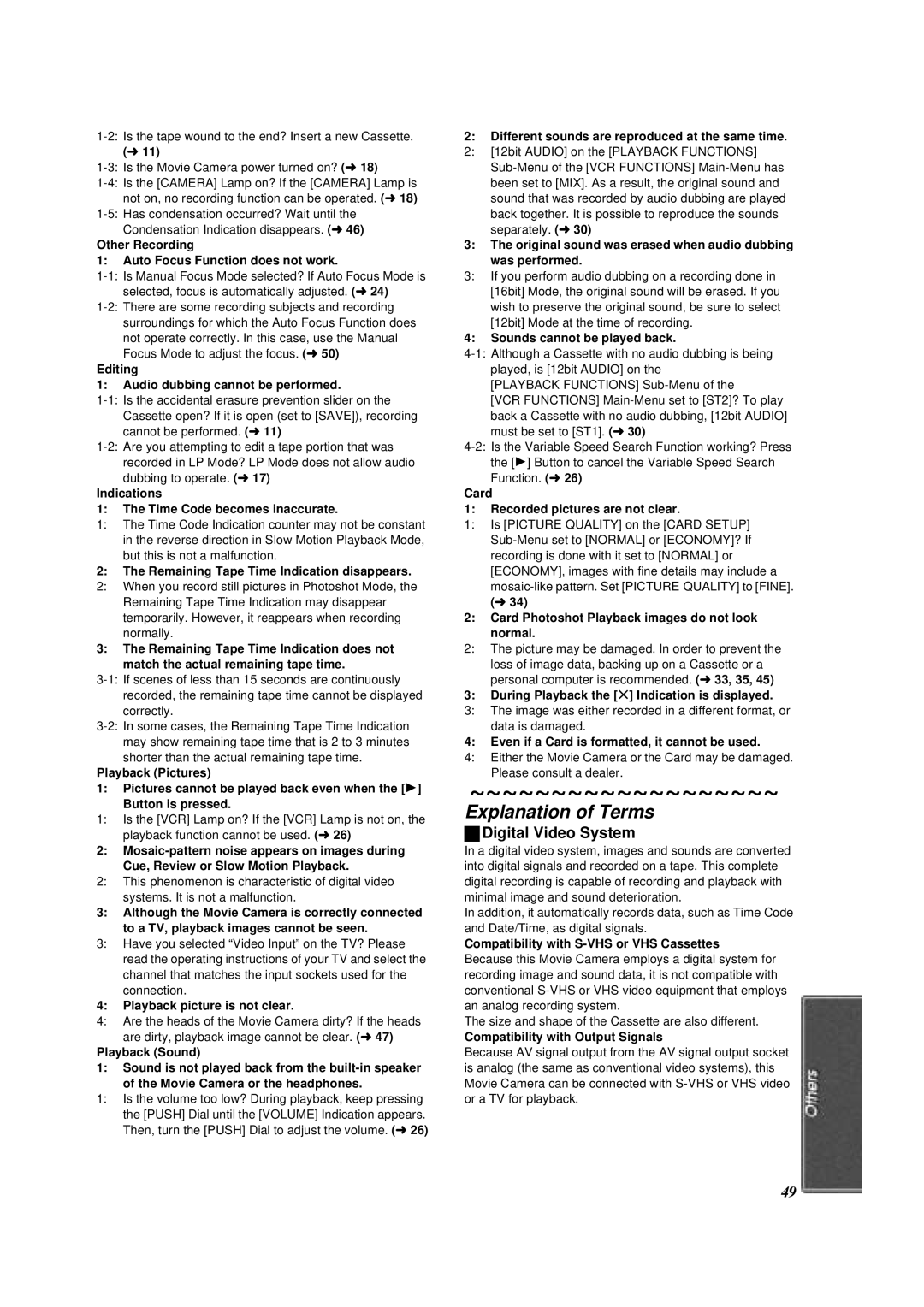
(l11)
Other Recording
1:Auto Focus Function does not work.
Editing
1:Audio dubbing cannot be performed.
Indications
1:The Time Code becomes inaccurate.
1:The Time Code Indication counter may not be constant in the reverse direction in Slow Motion Playback Mode, but this is not a malfunction.
2:The Remaining Tape Time Indication disappears.
2:When you record still pictures in Photoshot Mode, the Remaining Tape Time Indication may disappear temporarily. However, it reappears when recording normally.
3:The Remaining Tape Time Indication does not
match the actual remaining tape time.
Playback (Pictures)
1:Pictures cannot be played back even when the [1]
Button is pressed.
1:Is the [VCR] Lamp on? If the [VCR] Lamp is not on, the playback function cannot be used. (l26)
2:
2:This phenomenon is characteristic of digital video systems. It is not a malfunction.
3:Although the Movie Camera is correctly connected to a TV, playback images cannot be seen.
3:Have you selected “Video Input” on the TV? Please read the operating instructions of your TV and select the channel that matches the input sockets used for the connection.
4:Playback picture is not clear.
4:Are the heads of the Movie Camera dirty? If the heads
are dirty, playback image cannot be clear. (l47)
Playback (Sound)
1:Sound is not played back from the
of the Movie Camera or the headphones.
1:Is the volume too low? During playback, keep pressing the [PUSH] Dial until the [VOLUME] Indication appears. Then, turn the [PUSH] Dial to adjust the volume. (l26)
2:Different sounds are reproduced at the same time.
2:[12bit AUDIO] on the [PLAYBACK FUNCTIONS]
3:The original sound was erased when audio dubbing
was performed.
3:If you perform audio dubbing on a recording done in [16bit] Mode, the original sound will be erased. If you wish to preserve the original sound, be sure to select [12bit] Mode at the time of recording.
4:Sounds cannot be played back.
[PLAYBACK FUNCTIONS]
[VCR FUNCTIONS]
Card
1:Recorded pictures are not clear.
1:Is [PICTURE QUALITY] on the [CARD SETUP]
2:Card Photoshot Playback images do not look
normal.
2:The picture may be damaged. In order to prevent the loss of image data, backing up on a Cassette or a personal computer is recommended. (l33, 35, 45)
3:During Playback the [t] Indication is displayed.
3:The image was either recorded in a different format, or data is damaged.
4:Even if a Card is formatted, it cannot be used.
4:Either the Movie Camera or the Card may be damaged. Please consult a dealer.
~~~~~~~~~~~~~~~~~~~
Explanation of Terms
ªDigital Video System
In a digital video system, images and sounds are converted into digital signals and recorded on a tape. This complete digital recording is capable of recording and playback with minimal image and sound deterioration.
In addition, it automatically records data, such as Time Code and Date/Time, as digital signals.
Compatibility with S-VHS or VHS Cassettes
Because this Movie Camera employs a digital system for recording image and sound data, it is not compatible with conventional
The size and shape of the Cassette are also different.
Compatibility with Output Signals
Because AV signal output from the AV signal output socket is analog (the same as conventional video systems), this Movie Camera can be connected with
49
